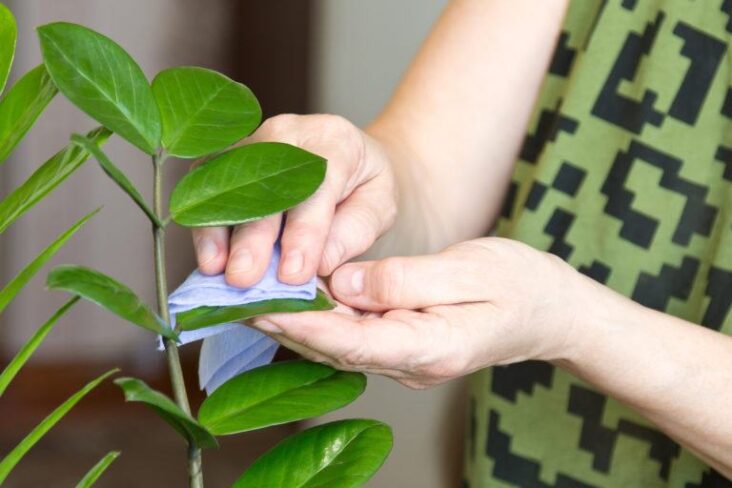Having indoor houseplants comes with several benefits. They help in beautifying your indoor space and often screen unpleasant spots. In addition to that, various studies have verified that growing houseplants inside your home will make you happy and healthy.
However, keeping several kinds of houseplants has its own set of problems, for example, pests, bugs, and others. Do your houseplants often get infected with bugs? In that case, this guide is perfect for you as we will show how to get rid of pests from your indoor plants.
If you have limited time to take care of the house plants from bugs, then make sure to visit plantscapelive.com, where experienced technicians and Horticulture specialists will come up with the best pest control solutions. Also, this website offers other services, including watering, trimming, plant replacement, seasonal rotations, and planter cleaning.
1. Isolating The Plant

First of all, if you think that the plant is infested with bugs, you have to move it to an isolated place and away from other plants. By doing this, you can stop the bugs from attacking other indoor plants. After isolating that plant, check whether the infestation is heavy or in an early stage.
Make sure to keep an eye on the surroundings because sometimes the bugs might temporarily hide in any nearby areas. After that, cover the soil using a plastic bag so that the insects would not fall into the surface. If the bugs drop on the potting soil, they might cause further damage to the plant.
2. Physically Picking Out The Pests
If there are large bugs like slugs, earwigs, millipedes, caterpillars, and others, it is better to pick and throw them out with your hands. You do not have to use your bare hand, so it is best to wear gardening gloves. If your indoor plant has a small insect infestation, you can use a nail file, stick, or related items to remove the bugs.
It is also best to use white ear swabs to eliminate tiny, fine white-colored pests on foliage. In the case of mealybugs and similar insects, you can utilize tweezers or a cotton bud scooped in alcohol. However, it is possible to take out some kinds of pests with an aggressive sprinkle of water.
3. Washing The Plant

Washing the houseplant, which is infested with bugs using mild liquid soap or insecticidal soap, is relatively beneficial. These liquids have the potential to kill pests if they get in touch with them. You have to be careful while choosing the soap because there are a few solutions that include detergents and degreasers, and they can be harmful to sensitive houseplants.
It is recommended to test the soap on a tiny part of the plant prior to using it on all leaves. Make sure to wash the pot also because some bugs tend to hide underneath the container or near the edge of the tray. If you want, you can also use wet, soft towels to wipe the plant leaves. For tiny houseplants, wash them in a basin or a sink. However, use a shower stall or a water pipe to wash large indoor plants.
4. Using Organic Pesticides
Counting on our experience, we recommend you to use organic pesticides over chemical pesticides as much as possible. While acquiring the pesticide, be cautious and check the label to ensure you are getting the right solution that is not dangerous to the indoor plant.
There are plenty of organic pesticides and miticides available in the current market, such as pyrethrin, rotenone, insecticidal soap, and many more. Besides that, granulated sulfur is also a decent organic fungicide.
5. Removing The Insect Residue

If you could not pull out the bugs, it is better to soak a small cotton swab in rubbing alcohol and smear it on the insects to annihilate and peel them off the indoor plant. Instead of alcohol, there are also other alternatives, such as neem oil, insecticidal soap, and more.
You can also use a cotton bud soaked in isopropyl alcohol in order to take out the egg sacs, webs, cocoons, and other residue left by the bugs. However, avoid using feather dusters for washing and cleaning the infested plants as they can transmit small insects or their eggs from one indoor plant to others.
6. Yellow Sticky Traps
Using the sticky trap is one best way to get rid of houseplant pests within a short period of time. The yellow and blue sticky traps help in controlling and trapping the adult aphids, whiteflies, leaf-miners, sciarids, thrips, and many others. These sticky traps can catch the bugs, and the entire infestation can be reduced. If you want to prevent bugs from coming near the houseplant, it is better to use dryer sheets.
7. Removing Some Soil

If the pest infestation is a little heavy, make sure to extract the top layer of the soil and pour it away. After that, you can put fresh potting soil or a surface cover. Remember that soil covers such as fine sand or a natural top surface can deter pest infestation.
8. Cutting Out Infested Branches
When the bug infestation is spread on many stems of the house plants, it is advised to cut them. For instance, if bugs are present on one or two stems, then pluck out those stems using a pair of sterilized scissors or garden pruners. Hence, it is best to remove all the branches that have bugs on them.
9. Throwing Away The Plant

Sometimes, the houseplant can be heavily infested with bugs where there would not be any scope to cure it. In that situation, it is best to throw that plant in order to save other plants from the bugs. If not, you can also compost the infected plant.
Bottom Line
Pest infestation is one of the common problems of growing plants, both indoor and outdoor house plants. However, you can get rid of the insects by using the above-mentioned tips, so make sure to follow them if you find insects in your indoor plants.

